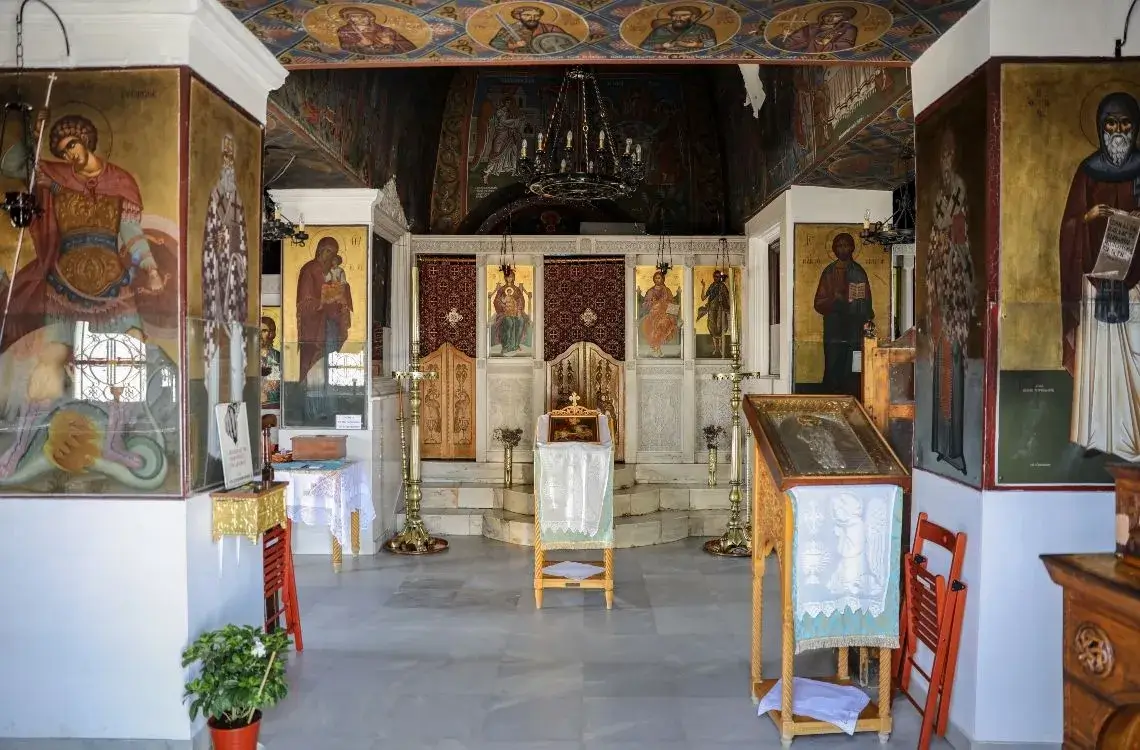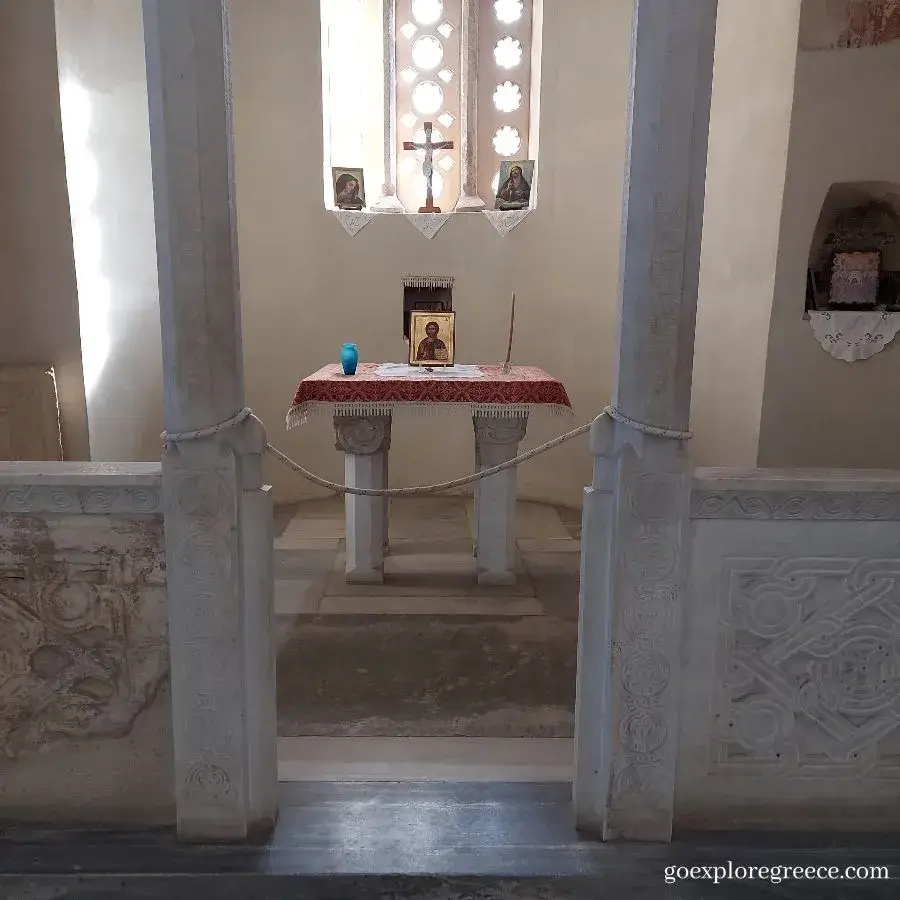




There are so many fantastic churches in Athens, and many are within easy walking distance from each other. But, many tourists get into trouble when they try to take photos, as they don’t understand the need to beware of taking photographs inside churches in Greece.
So, in this blog post, I’m going to explain why taking photos in Greek orthodox Churches is often frowned upon and not allowed. But, the good news is that I’m also going to provide you with some simple rules to follow, which will not only increase your chances of getting permission to take photos, but also stand a good chance of the priest pointing out the best places to take them.
Why is taking photos inside Churches in Greece often not allowed?
If you have been to a church in Greece, you may have seen the “no photography” sign at the doorway or inside and didn’t dare to take any photos.
Or, there were no signs, but as you started to take a photo, you were stopped by the stern and abrupt voice of the priest telling you “NO”. So, why is taking photos in a Greek Orthodox church sometimes frowned upon, even if you are not using a flash?
Actually, the reason is spiritual. Eastern Orthodox Christianity, the traditional faith in Greece, places a particular emphasis on mysticism, the psychological state of being in direct contact with the divine.
Everything in the church, from the people praying, the visual impact of icons, the flicker of candles, the smell of incense, and the chants of the priests, helps to create a memorable and intimate atmosphere and is meant to inspire direct and personal immersion.
So, this makes for an interesting question about the role of photography in this process and how it potentially interferes with the mystic experience.
One might say that the flash and the click of the camera could destroy the atmosphere and hence the experience, but what if the flash and click are turned off?
Well, it’s not really the physical effect of picture-taking but rather the role of the photographer. Since mysticism is understood as a state of unity with God, which is sacred and intimate, the photographer becomes a witness to a personal act that could violate the believer’s privacy.
“But,” you say. “if praying in a church is never private anyway, and it’s not embarrassing, to begin with. If other people are present and some are watching, then why is it okay to be watched but not okay to have a photo taken?”
Well, that’s a good question, and in discussions with Greek Orthodox priests, the following three reasons are the best that I can figure out:
- Perhaps the problem is that in a church, everyone is supposed to be an invested participant, but while a camera is in your hands, that makes you an outside witness and what your camera is observing becomes a sort of spectacle when not an immersion.
- Or maybe because a picture takes away the context and trivializes one separate instance of the experience, thus skewing its meaning.
- it could be related to the Orthodox aversion to anything mechanical happening in the church, which is why no musical instruments are used in church music.
My top simple-to-follow rules for taking photographs inside churches in Greece
As in many other countries, Greece requires specific permissions and etiquette which must be followed when taking photographs inside Churches. So, here are my top simple-to-follow rules for taking photographs inside churches in Greece.
- Look at the entrance before you go inside and see if there are signs informing you not to take photographs.
- If you are unsure whether it is appropriate to take photos, ask a church staff member or another visitor.
- Be respectful of religious services and ceremonies that may be taking place, as it may not be allowed to take photos.
- If you have a mobile phone, turn the volume off or put the phone into aeroplane mode.
- Do not use a selfie stick, tripod or any type of equipment that clips onto or attaches itself to objects while holding your camera or phone.
- Do not take any selfies.
- Be mindful of flash photography which is usually not allowed, as it can be disruptive and disrespectful. Ask permission, and if you have permission to use a flash, do so sparingly.
- Avoid taking photos of people without their permission. Many people come to churches for reflection and prayer and may not want their pictures taken without consent. In particular, Greek law makes it illegal to photograph children (even by accident) without their parents’ consent.
- Think about leaving a contribution in one of the collection boxes or plates on leaving the church.
By following these simple guidelines, you can ensure that your visit to churches in Greece is enjoyable and respectful.
Which are the best churches in Athens for taking photos?












There are so many fantastic churches in Athens, and many are within easy walking distance from each other. There are Ancient and Byzantine temples, Christian and Orthodox hideaways, churches over 1000 years old, and even a cathedral. So, here’s a list of my top six churches in Athens which are great for taking photographs.
- Holy Church of Saint George on Lycabettus Hill is a small whitewashed Holy Church of Saint George on Lycabettus Hill in Athens was built in 1870. It is one of the most popular tourist destinations in the city.
- Holy Church of Saint Kyriaki is a tiny Greek Orthodox church hiding on a busy city street. Built in the early 1600s to honour a Christian saint martyred under a Roman emperor, it is one of the smallest churches in Athens
- Metropolitan Cathedral of Athens is the cathedral church of the Archbishopric of Athens and Greece. Built in 1862, the Metropolitan Cathedral of Athens, more popularly known as the Metropolis, is the cathedral church of the Archbishopric of Athens and Greece.
- Church of Panagia Kapnikarea Located in Ermou St, the main shopping street of Athens, it was built about 1050 AD on the site of a Greek temple. It’s probably the oldest church in Athens.
- The Church of Hagia Dynamis is a 16th-century church serving as a shrine for pregnant women and pays homage to the Virgin Mary. Below is a blocked 50-foot tunnel connecting it to a cave system.
- The Church of the Holy Apostles Athens is perhaps the oldest church in Athens. Built around 1000 AD, the Church of Holy Apostles Athens is located in the Ancient Agora of Athens. It has survived intact since it was built.
In summary
As I mentioned at the beginning of this post, there are so many fantastic churches in Athens, and many are within easy walking distance from each other. Whilst there are churches in Athens which do not allow the taking of any photographs, there are plenty to choose from which do. So, whether you are interested in classical antiquity or more recent history, these churches in Athens offer a little something for everyone.
